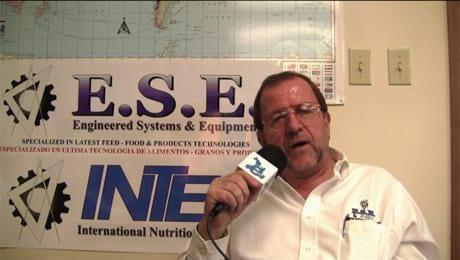Check out what is new in Animal Feed
Find the best technical articles, forums, and videos on Animal Feed at Engormix. Enter now and interact with the world's largest agricultural social network.
.jpg&w=3840&q=75)
Charles Starkey, VP of Scientific and Regulatory Affairs at the North American Renderers Association (NARA), talks about the benefits of rendering and sustainability...
Comments : 0
Recommendations: 1
1. Introduction Both L-glutamate (Glu) and L-glutamine (Gln) are abundant amino acids (AAs) in plant, microbial, and animal proteins [1]. In the whole bodies of sheep and cattle, Glu and Gln are the third and eighth most abundant AAs, respectively. For comparison, the total content of these two AAs, along with other AAs, in feeds [e.g., Bermuda grass, distillers dried grains, and solubles (DDGS)], ruminal microbes, and skeletal muscle proteins is also relatively high, as summarized...
Comments : 1
Recommendations: 0


Pre- Pelleting Process in Aquafeed Production Josef Barbi (E.S.E. & Intec)
Suggested link
by Lyndsey Johnston
Insects and derived products are possible alternative feedstuffs to improve the sustainability of the livestock sector due to several promising attributes such as limited space requirements for growing larvae, short productive cycles, limited water needs and the suitability of some species to mass rearing. Also, some insect species can contribute to circular economy models by upcycling organic side-streams from other industries into high-value...
Comments : 1
Recommendations: 0
Introduction In developing countries, the poultry industry is experiencing some critical issues with animal feed prices, which are unpredictable in the current scenario, as raw ingredients, primarily corn and soybean, have been increasing in price day by day (Alagawany and Attia 2015). As a result, there is a need to consider some low-cost resources, such as agricultural by-products and other crops, which are significantly less expensive than conventional feed stuff. As a result,...
Comments : 0
Recommendations: 1
.jpg&w=3840&q=75)
Join Lanny Smith, Global Sales Manager at VICAM, as he unveils how VICAM sets itself apart in the realm of mycotoxin testing solutions for the feed chain....
Comments : 0
Recommendations: 1
.jpg&w=3840&q=75)
Charles Starkey, VP of Scientific and Regulatory Affairs at the North American Renderers Association (NARA), talks about the Lifecycle data on the sustainability of Rendered Products of Pet Food...
Comments : 0
Recommendations: 0


Pre- Pelleting Process in Aquafeed Production Josef Barbi (E.S.E. & Intec)
Suggested link
1. Introduction Infectious bronchitis (IB) and Newcastle disease (ND) are highly transmissible diseases that cause substantial economic losses in the poultry industry [1, 2]. Infectious bronchitis is caused by infectious bronchitis virus (IBV), a gammacoronavirus with a single-stranded positive sense RNA genome [3]. Newcastle disease is caused by virulent strains of Newcastle disease virus (NDV), a paramyxovirus with a single-stranded negative sense RNA genome [4]. Infectious...
Comments : 0
Recommendations: 1
Introduction Creatine (essential for energy metabolism) and glutathione (GSH; an important non-enzymatic antioxidant) are major metabolites of glycine [the simplest amino acid (AA)] in animals (Fig. 1). Specifically, arginine:glycine amidinotransferase (AGAT) and guanidinoacetate N-methyltransferase (GAMT) convert glycine into creatine in the presence of arginine and methionine, whereas γ-glutamylcysteine synthetase and glutathione synthetase catalyze the formation of GSH...
Comments : 1
Recommendations: 0
.jpg&w=3840&q=75)
"Listen to Dr. Markus Wiltafsky-Martin as he discusses the recent USA patent validating the scientific advancements of AMINONIR® RED and its unwavering accuracy in providing reliable nutritional data...
Comments : 0
Recommendations: 2
.jpg&w=3840&q=75)
Jean Stoll (Global Head of Protein and Dairy at Maersk) talks about innovation, reach, transit times, and requirements of poultry shipping, in this Engormix interview....
Comments : 0
Recommendations: 0


Pre- Pelleting Process in Aquafeed Production Josef Barbi (E.S.E. & Intec)
Suggested link
1. Introduction Increased atmospheric emissions of greenhouse gases (GHGs), such as nitrous oxide (N 2 O), carbon dioxide (CO 2 ), and methane (CH 4 ), are the primary cause of climate change. These emissions result in unpredictable and erratic rainfall, floods, and droughts [1]. In 2020, agriculture contributed 5865.47 MtCO 2 e, representing 12.34% of its total emissions (47,513.15 MtCO 2 e), including land-use change and forestry...
Comments : 0
Recommendations: 0
4.1 Introduction The metabolism of most nutrients in domestic dogs and cats is similar to that in other mammals (Baker and Czarnecki-Maulden 1991). Thus, the qualitative dietary requirements of dogs and cats for most nutrients [e.g., amino acids (AAs) that are not formed de novo in animal cells] are similar to those for omnivores (e.g., humans and pigs). However, dogs and cats have a relatively short digestive tract (He et al. 2024) and have evolved to have some unique feeding...
Comments : 1
Recommendations: 0
.jpg&w=3840&q=75)
Rendering is a vital part of sustainable agricultural production. Renderers take the parts of animals that North Americans choose not to utilize and make them into valuable products like livestock feed, pet food, biofuel, fertilizer, and other industrial products. The truth about rendering is much different than you may have been told....
Comments : 0
Recommendations: 0
Farm Foundation is excited to announce the recipients of the 2024 Farm Foundation Awards. Farm Foundation’s annual awards program recognizes those who exemplify our mission and values. There are two lifetime achievement awards and two innovator awards.
The four award...
Comments : 0
Recommendations: 0


Pre- Pelleting Process in Aquafeed Production Josef Barbi (E.S.E. & Intec)
Suggested link
In the realm of food safety, mycotoxins present a significant challenge to manufacturers, processors, and regulatory bodies alike. These toxic compounds, produced by certain fungi under specific environmental conditions, can contaminate various food and feed products, posing serious health risks to consumers and...
Comments : 0
Recommendations: 2
INTRODUCTION Maize (Zea mays L.) is a staple food in many parts of the world including sub-Saharan Africa (SSA). In Nigeria and some other West African countries, it is traditionally transformed by submerged fermentation to ogi – a complementary weaning food for infants and young children, convenient food for the sick, convalescent and elderly or quick breakfast mostly for those living in rural areas characterized by low income (Onyekwere et al., 1989; Steinkraus,...
Comments : 0
Recommendations: 0
Introduction Modern maize, belonging to the genus Zea, was domesticated in southern Mexico 9000 years ago from wild, annual tropical grasses called teosintes, with the primary ancestor being Parviglumis (Zea mays ssp. parviglumis) which survives today in the wild (Matsuoka et al., 2002). There are additional species of teosintes that continue to grow in the wild in Mexico and Central America including the perennial Zea diploperennis (Iltis and Doebley, 1980). Following its...
Comments : 0
Recommendations: 0
_1.jpg&w=3840&q=75)
Frank Ivey (Feed2Gain) shares his experience and insights on diet changes, cost savings in formulations, as well as how the impact of enzymes is evaluated, in this Engormix interview....
Comments : 0
Recommendations: 3


Pre- Pelleting Process in Aquafeed Production Josef Barbi (E.S.E. & Intec)
Suggested link
.jpg&w=3840&q=75)
AMINONIR® delivers swift nutritional insights, aiding stakeholders in the livestock feed chain. Its rapid analysis ensures timely, informed decisions, optimizing efficiency and nutritional precision. Hear what Dr. Markus Wiltafsky-Martin from Evonik has to say about it...
Comments : 0
Recommendations: 2
















.jpg&w=3840&q=75)


